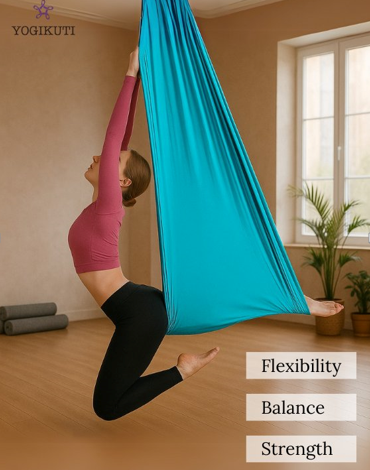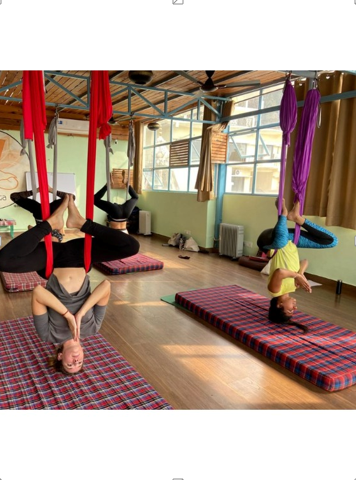Aerial Yoga Hammock: A Complete Guide

Yoga is changing in so many cool ways, and one of the most enjoyable and effective styles is aerial yoga. Rather than practicing solely on a mat, you practice using a special fabric called an aerial yoga hammock. Your body is supported by this hammock, allowing you to move freely in the air, and it assists you in discovering yoga from a completely new perspective.
In this complete guide, we’ll explain what an aerial yoga hammock is, its benefits, how to use it, and what to consider before buying one.
Alt Text – Yogikuti aerial yoga hammock for strength, flexibility, and balance. Durable fabric prop supports inversions and poses for safe aerial yoga practice
What is an Aerial Yoga Hammock?
An aerial yoga hammock is a long, strong piece of fabric, usually made from nylon or silk. It is hung from the ceiling or a frame using carabiners, hooks, and daisy chains.
This hammock enables you to do yoga poses while supported above ground. You can sit, stretch, hang upside down, or swing lightly. It makes yoga more fun and also offers deep stretching and muscle activity.
Benefits of an Aerial Yoga Hammock
Yoga performed with an aerial hammock has numerous physical and mental advantages:
- Spinal Decompression – Hanging upside down allows the spine to relax and lengthen, alleviating back pain.
- Enhanced Flexibility – Deeper stretching in the hammock is done without straining.
- Enhanced Strength – Suspending yourself in the hammock activates core, arms, and legs.
- Improved Balance – Balancing in the air enhances coordination and balance.
- Stress Reduction – Floating motions are soothing and relieve anxiety.
- Playfulness and Creativity – Adds fun and playfulness to your yoga practice.

Alt text – Two women practicing aerial yoga inversions using hammocks in a yoga studio, enhancing flexibility, strength, and balance with anti-gravity poses
Aerial Yoga Hammock vs Aerial Swing
Some people confuse an aerial yoga hammock with an aerial swing. While they look similar, there are differences
| Feature | Aerial Yoga Hammock | Aerial Swing |
| Fabric | Wide, long fabric (like a cocoon) | Narrower fabric with handles or padding |
| Best For | Traditional yoga poses, restorative yoga | Fitness, acrobatics, strength-based training |
| Support | Full-body support, can wrap around you | Supports mainly hips and upper body |
| Comfort | Softer and more relaxing | More structured, less cocoon-like |
How to Use an Aerial Yoga Hammock
If you’re new to aerial yoga, start slowly and safely. Here are some common ways to use a hammock:
1. Supported Backbend
Sit in the hammock, lean back, and let it support your spine. This opens the chest and shoulders.
2. Inverted Pose
With guidance, you can flip upside down by wrapping your legs around the hammock. This decompresses the spine and improves circulation.
3. Floating Savasana
Lie inside the hammock like a cocoon. This is deeply relaxing and reduces stress.
4. Core Workouts
Hold yourself up in the hammock while engaging your abs. It’s a great way to build strength.
5. Gentle Swinging
Simply swinging in the hammock calms the mind and improves mood.
See also: More Than Clean Teeth: The Link Between Oral Health and Overall Wellness
Who Can Use an Aerial Yoga Hammock?
Almost anyone can benefit from practicing with an aerial yoga hammock:
- Beginners – For support in new poses.
- Intermediate Yogis – To explore deeper stretches.
- Advanced Yogis – To try challenging aerial movements.
- People with Back Pain – To relieve spinal pressure.
However, it may not be suitable for people with certain health conditions (high blood pressure, vertigo, recent surgery). Always consult a doctor if unsure.
Safety Tips for Aerial Yoga Hammocks
Practicing in the air is fun but needs safety. Keep these points in mind:
- Use strong support – Ensure your ceiling, frame, or stand is strong enough to hold weight.
- Check the hammock setup – Make sure knots, hooks, and carabiners are secure.
- Start with a teacher – Beginners should learn from an instructor before practicing alone.
- Wear fitted clothes – Avoid loose clothing that may get tangled.
- Stay within your limit – Don’t force advanced moves too quickly.
Choosing the Right Aerial Yoga Hammock x
When buying an aerial yoga hammock, consider these features:
- Material: Nylon tricot and silk are common; nylon is stretchy, silk is softer.
- Size: Standard hammocks are 5–6 meters long. Choose based on ceiling height.
- Weight Capacity: Most hammocks hold 300–600 lbs. Check before buying.
- Color & Style: Pick a color that makes you feel relaxed and inspired.
- Accessories: Ensure it comes with hooks, carabiners, and daisy chains.
Aerial Yoga Hammock for Home Practice
The best part is, you can practice aerial yoga at home. All you need is:
- A strong ceiling beam or stand.
- An aerial yoga hammock kit.
- A safe space with no sharp edges around.
Beginners may start with gentle poses like supported sitting, lying stretches, and floating savasana. With practice, you can explore more dynamic movements.
Care Tips for Aerial Yoga Hammocks
To make your hammock last longer:
- Wash the fabric gently in cold water.
- Avoid sharp jewelry that may tear it.
- Store in a dry place away from sunlight.
- Regularly check knots and equipment.
conclusion
The aerial yoga hammock is more than just a prop – it’s a doorway to new yoga experiences. Experience spinal relief, improved strength, and more fun in your yoga routine—all with added comfort
Whether you want to relax in a floating savasana, deepen your stretches, or enjoy playful yoga in the air, the hammock makes it possible.
If you are ready to energize your practice and explore yoga in a new way, an aerial yoga hammock is the perfect choice.





